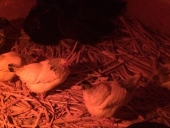There are a lot of variables at play, so I doubt anything but "wait and see" experimentation will answer this. I live in northern Canada between Rocky Mountain foothills and prairie, and in our case, 4 inch vents don't seem to be drop the temperature early enough or keep it low enough long into February / March / April, even though nighttime temperatures are well, well below freezing. Some of my variables: ours touches an uninsulated foundation of the house (soon to be insulated), and the vents are not in particularly exposed locations, and not aligned with the prevailing winds.
If it's near enough to the house, a $15 battery-powered weather station with a wireless transmitter is a handy way to monitor the temperature in the root cellar. Plug the vents, partially or completely, if the weather's getting too cold.
I'm going to be using a timer outlet to run an in-duct fan on the vent at night - with the addition of an thermostat to shut off the fan before everything is frozen solid. (Inkbird ITC-308.) With the fan, timer and thermostat, I think I should be able to keep the place at ideal temperature well into April and probably even May, given our cool nighttime temperatures. It's a little too high-tech for my liking, but should keep us in root vegetables until we're planting next year's crop. If it works well, I'll have a 12 x 14 foot refrigerator for a microscopic fraction of the electric bill that would otherwise require.
(I THINK you could use two of the Inkbird thermostats in series, to run the fan anytime it's cooler outside than in the root cellar, but I can trust overnight cool temperatures, and already have the timer.)





